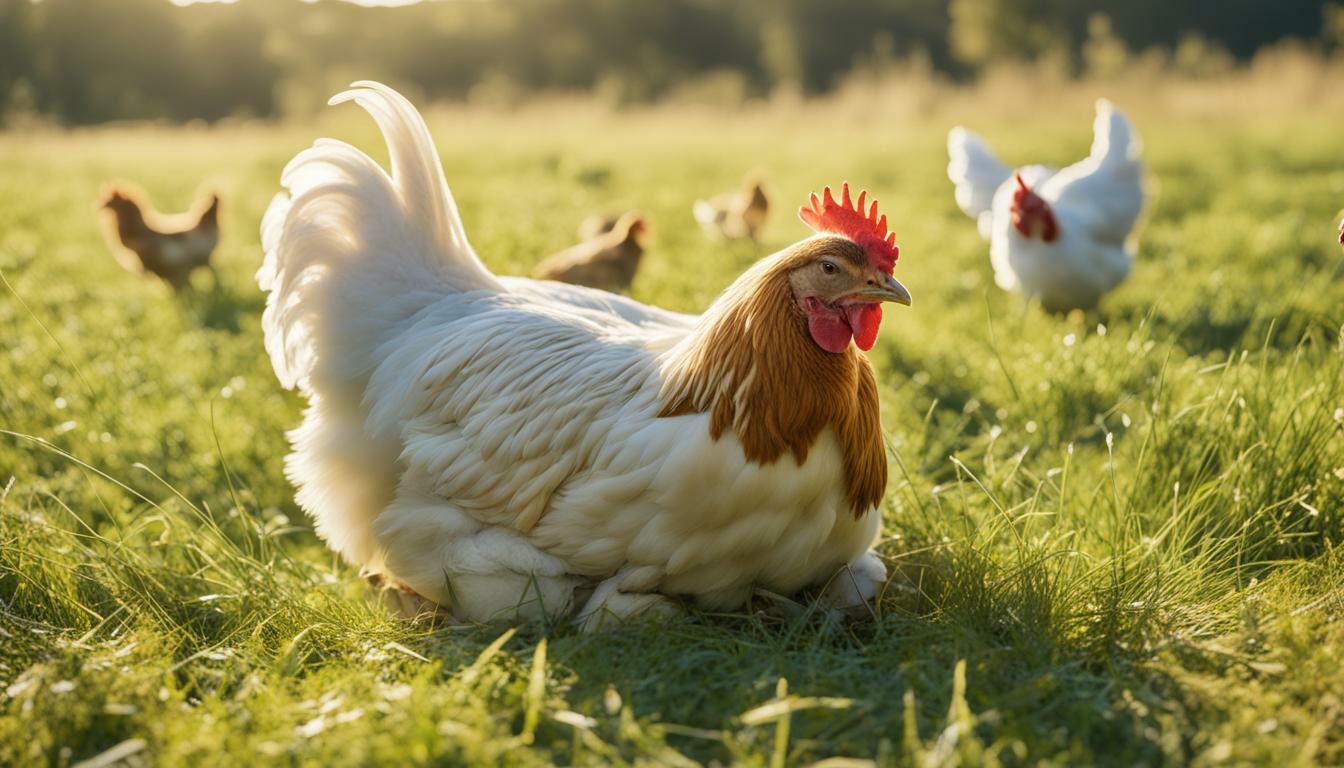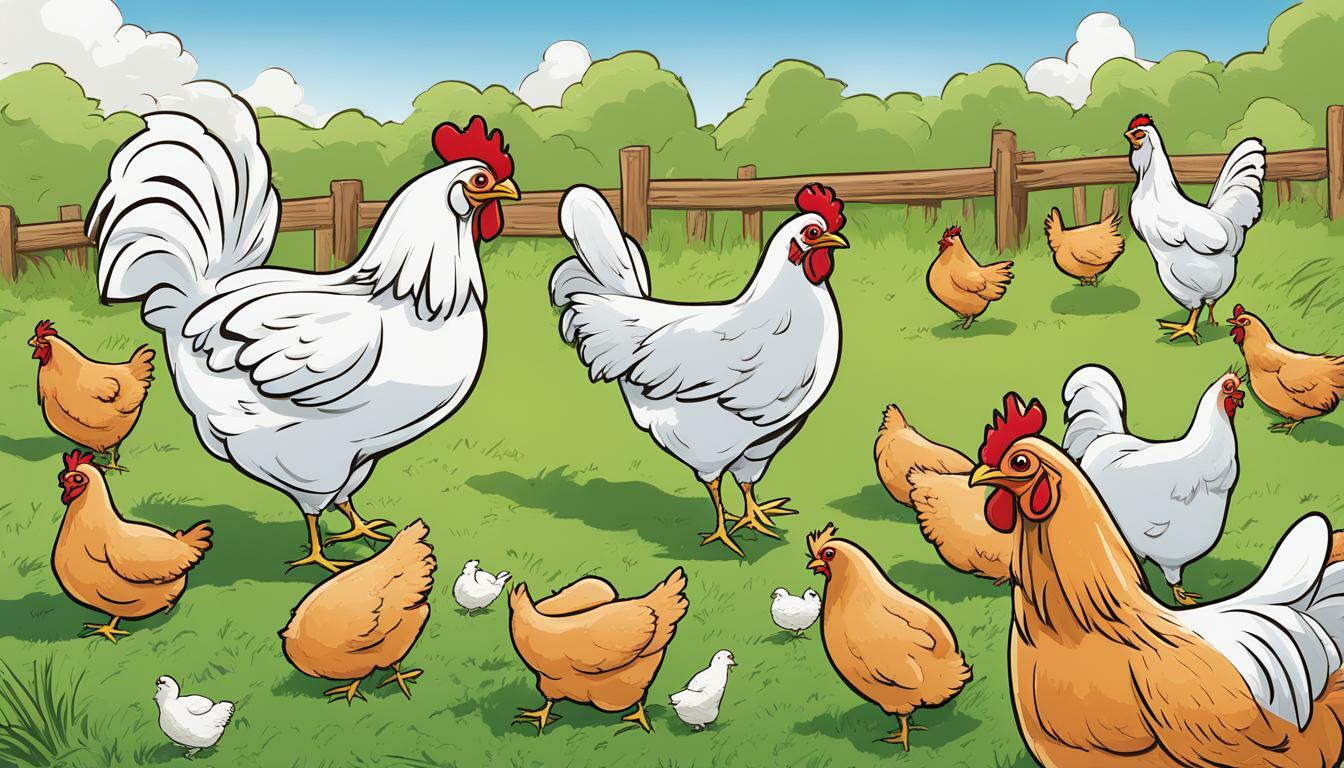Why do Chickens Lay on their Side?

Table of content:
Chickens laying on their side, also called “lying down”, is a common behavior seen in backyard flocks. While it’s natural for hens to lay down occasionally, extended periods of side-laying can signal an underlying health issue. Understanding the reasons behind this unusual behavior is key to keeping your flock happy and healthy.
Normal Chicken Laying Behaviors
To understand when side-laying is problematic, it’s helpful to first review normal laying behaviors in chickens.
Nesting – Prior to laying an egg, a hen will scout for a suitable nesting area. This is an instinctive behavior to keep eggs protected. She may visit multiple spots before settling into a nest.
Egg Song – Just before laying, you may hear a hen make clucking noises. This “egg song” communicates to the flock that an egg is coming.
Laying – The hen will hunker down into the nest and contract her abdominal muscles to push out the egg. This takes just a few contractions and moments.
Resting – After laying, a normal hen will remain in the nest for 5-15 minutes. This allows the egg to fully descend before getting up.
Inspecting – Once rested, the hen will stand up and often turn back to inspect the freshly laid egg before leaving the nest.
Wandering – A hen that has recently laid an egg may wander slowly around the run. This gentile activity allows her reproductive organs to return to normal.
When is Laying on Side Problematic?
Chickens naturally lay on their sides while sleeping and resting. In moderation, this is completely normal flock behavior. Side-laying becomes a concern when it is prolonged, frequent, or the hen appears distressed.
Signs that side-laying is abnormal include:
- Hen lays on her side for over an hour at a time
- Side-laying occurs multiple times throughout the day
- Noticeable difference from her normal activity levels
- Obvious discomfort signs like panting or vocalizing
- An inability to stand up on her own
Any of these indicators warrant a closer look to identify the underlying cause. Catching issues early maximizes the chance of successful treatment.
Common Causes of Abnormal Side-Laying
There are a few common reasons a hen may spend excessive time on her side. Being able to distinguish between them is key to proper treatment.
Molting
Molting is the natural shedding and regrowing of feathers. It occurs 1-2 times per year and causes a temporary drop in egg production.
Hens will lay on their sides more frequently during a molt. The energy spent regrowing feathers leaves them tired.
Provide extra protein during molts to support feather regrowth. Molting side-laying is not dangerous on its own.
Egg Binding
Egg binding happens when a formed egg gets stuck in the reproductive tract. It causes straining, discomfort, and lack of appetite.
A bound hen will lay on her side, often straining. She may get up and down frequently. Her abdomen will appear swollen.
Binding requires prompt veterinary care. Soaking the hen’s vent in warm water can help relax muscles and allow egg passage.
Impacted Crop
The crop is a pouch along the throat that stores food before moving to the stomach. Crop impactions happen when the crop becomes clogged.
Impactions make hens feel unwell and lethargic. Affected hens may lay on their side with a swollen crop.
Impactions can be massaged to loosen or require treatment to resolve. Offering olive or coconut oil can help lubricate blockages.
Respiratory Illness
Respiratory diseases like infectious bronchitis cause upper airway inflammation. Sick hens will lay on their sides to support breathing.
Ill hens appear fluffed up and breathe with an open beak. They may make rasping noises.
Respiratory disease requires prescription antibiotics and anti-inflammatory medication. Isolate sick birds during treatment.
Overheating
Chickens are susceptible to heat stress in hot weather. To cool themselves, overly warm hens will lay flat against the ground.
Overheated hens breath heavily and hold their wings away from their bodies. Their combs may appear pale or discolored.
Misting hens with cool water and offering frozen treats can help prevent overheating. Ensure adequate shade is available.
Predator Fright
Sudden fright by a real or perceived predator can cause a condition called “predator paralysis”. Hens lay on their side, paralyzed by fear.
This temporary paralysis resolves once the scare has passed. Try to identify the trigger and prevent future incidents.
Musculoskeletal Injury
Injuries to muscles, bones, or nerves can leave a hen unable to stand properly. Common causes include fights with flockmates and getting stuck in housing.
Injured hens will lay on their side with the injured leg stretched out. They may resist standing.
Isolate injured birds until they can move normally to prevent worsening damage. Consult a vet for non-healing wounds.
Egg Peritonitis
Egg yolk peritonitis occurs when yolk material leaks into the abdominal cavity, causing inflammation and infection.
Affected hens appear droopy, weak, and underweight. They frequently lay on their sides due to abdominal pain and weakness.
This condition requires prescription antibiotics and anti-inflammatory medication. The prognosis is often poor.
Marek’s Disease
Marek’s disease is a viral infection that impacts nerves, causing paralysis in chickens. It most often strikes young birds.
Infected hens are unable to stand and spend extended time lying on their sides. They deteriorate rapidly.
There is no treatment for Marek’s. Euthanasia is typically recommended to prevent suffering. Vaccination helps prevent outbreaks.
Caring For A Hen Laying On Her Side
If you notice a hen spending excessive time on her side, act quickly to minimize complications. Here are some tips for caring for a recumbent hen:
- Isolate – Move the hen to a safe, comfortable pen apart from the flock to prevent injury and allow tailored care.
- Hydrate – Use an electrolyte solution and provide ample fresh water to prevent dehydration.
- Feed – Offer favorite treats, supplements, and mash to encourage eating.
- Clean – Keep the pen tidy to avoid contact with droppings. Wash and dry soiled feathers.
- Cushion – Line the pen with soft bedding, towels or cardboard to prevent sores.
- Treat – Administer any prescribed medications carefully according to directions.
- Monitor – Keep a close eye on appetite, drinking, and droppings. Contact a vet if condition deteriorates.
- Stimulate – Gently encourage the hen to move around as she is able to prevent muscle wasting.
- Comfort – Spend time petting and reassuring your hen to reduce stress.
With attentive home care and veterinary guidance when needed, most side-laying chickens can make a full recovery and return to normal flock life. Have patience, and allow ample recuperation time even after your hen is back on her feet.
Preventing Abnormal Side Laying
While some causes of side-laying like molts are unavoidable, you can take steps to reduce other risks:
- Select calm, friendly breeds to avoid injuries from flock disputes.
- Discourage bullying and competition over resources like food, water and nest spaces.
- Add roosts and ramps at different heights to accommodate chickens of all abilities.
- Ensure housing has adequate ventilation and ability to stay cool in summer.
- Limit stressors like loud noises, changes in routine, or predators.
- Provide a nutritionally complete feed and access to insoluble grit for digestion.
- Control parasites like mites that can weaken a hen’s health.
- Vaccinate chickens against contagious diseases like Marek’s where possible.
- Remove hazards like small spaces, toxic plants, and loose strings chickens could get trapped in.
- Know the normal egg-laying frequency and behavior of each hen to note changes.
- Handle hens gently and minimize stressful events like transporting whenever possible.
By taking proactive steps to support chicken health and wellbeing, abnormal side-laying can often be prevented.
When to See a Veterinarian
While many instances of side-laying resolve with rest and supportive care, veterinary expertise is recommended in certain scenarios, including:
- Side-lying for more than 24 hours without improvement
- An inability to stand or bear weight on legs
- Loss of appetite beyond 24 hours
- Difficulty breathing
- Signs of illness like discharge, diarrhea, vomiting
- Swollen abdomen, stretched vents
- Past history of laying issues
- Older or weak birds
Chickens are adept at hiding illness. Don’t delay in consulting an avian vet if side-laying persists or worsens. They can assess your hen’s condition, provide treatment options, and advise on home care for optimal recovery.
Final Thoughts
Side-laying in chickens can result from normal activities like nesting to more concerning causes like health problems. As a chicken keeper, being able to recognize abnormal side laying is an important skill. Quickly isolating affected hens can allow for diagnosis and treatment to get your flock back to normal as soon as possible. With attentive observation and care, chickens that lay on their sides excessively can go on to live long, healthy, active lives in your flock.
Welcome. I’m Adreena Shanum, the proud owner of this website, and I am incredibly passionate about animals, especially poultry. I founded adreenapets.com as a labor of love, stemming from my desire to share my knowledge and experiences with poultry enthusiasts worldwide.




